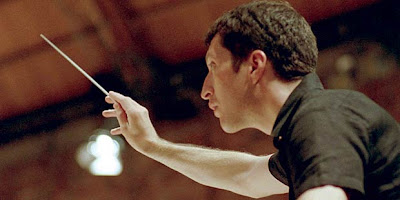Adès Leads the BSO
 Thomas Adès, composer (b. 1971) |
The orchestra was reduced to classical proportions for the Beethoven, with a compact assortment of strings (with concertmaster Jonathan Carney away this week, associate concertmaster Madeline Adkins took his place). The pairs of winds and timpani were separated by a short distance at the back (of course, the arrangement may not have been decided by Adès). Adès' precise, jumpy style of gesture is part of how he uses his body as an expressive device, sometimes lunging, twisting, hunching down. With a careful control of the relative weight of each section, Adès allowed the wind solos or accents to be heard and marshaled those reserve resources for booming crescendi. The first symphony had a balletic slow movement, emphasizing the con moto over the cantabile, and a decidedly scherzo-like menuetto with parallels to the rhythmic distortions in triple meter heard later in the Eroica. Although underplayed, the first is an impressive achievement for the 30-year-old Beethoven, with many nods to symphonic tradition and just as many hints of more ground-breaking changes to come.
Anne Midgette, The BSO, Awkward Now and Then (Washington Post, May 17) Tim Smith, Beethoven frames Ades' rich concerto (Baltimore Sun, May 17) Molly Sheridan, Composer Thomas Adès, Trading Pen for Baton In BSO Performances (Washington Post, May 15) |
The centerpiece of the evening was a new violin concerto by Adès, op. 24, given the title Concentric Paths. Premiered in Berlin in 2005, the work is a flirtation with minimalism, or at least with the technique of motoric repetition in overlapping cycles or phases. The first movement, Rings, opens with an oscillating motif and is oriented toward the treble colors, with some tinkling percussion that briefly reminded me of the Banquet scene from The Tempest. British violinist Anthony Marwood, who also plays as part of the Florestan Trio, assayed the solo part's stratospheric challenges with the ease one would expect from the musician who premiered the work. In the weighty second movement, Paths, a spiraling series of chords cycled its way through the orchestra, weaving around the solo line, with the menace of bass trombone, tuba, and double bass and the dull thud of pitchless percussion. The third movement, Rounds, had the feel of a cross-footed bossa nova. It was not what one might call a masterpiece, but it would be worth hearing again.
Next weekend, the BSO will focus on the music of Gershwin (May 22 to 24), with Marin Alsop back at the podium. Jean-Yves Thibaudet will play both the Concerto in F and the original orchestration of Rhapsody in Blue, made for the Paul Whiteman Band. Throw in Ravel's Tombeau de Couperin for good measure.





















































No comments:
Post a Comment